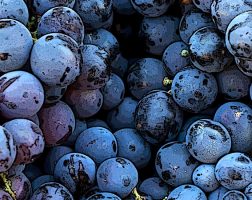Fruits
Almost all fruits grown in Iowa are perennial. Most will take 3 to 7 years to begin fruiting. In today’s changing climate, it can be hard to predict what will survive and thrive, but we offer these suggestions based on the latest available information.
Common Threat
In berries, spotted wing drosophila (SWD) – an invasive fruit fly that lays its eggs inside the fruit. In other fruits, a variety of insects and diseases.
Best Management
Sustainable commercial growers use organic pesticides and Integrated Pest Management.
Common Capital Expense
Bird netting as fruit ripens and mulching for weed control, (though mulch may increase vole problems for tree fruit), processing equipment and licensing. Trees with tree tubes for protection and in areas with heavy deer pressure, 8-foot fence.
Common Labor Expenses
Weeding, harvesting labor and/or equipment, pruning, mowing and insect and disease management.
Landowners Lessons

VERN AND MARY ZAHRADNIK
We wanted to farm how our parents farmed. We had seen that this was a successful model and we wanted to replicate it. In 1977, we rented 200 acres and raised corn, soybeans, oats, hay, and sheep. The problem with replicating past successes is that markets and land prices change. So, over the 40 years that we’ve farmed, we have adapted and changed our operation, including the land we farm and the types of crops we produce.
By the time we purchased our own land in 1996, we were raising corn and hogs. With our new farm we found more freedom to trial new crops, including vegetables, apples, and grapes. We used our hog operation to fund our new specialty crop enterprises. We were excited to have the ability to grow, harvest, and sell our products directly to customers.
At the same time these new enterprises flourished, feed prices for the hogs skyrocketed. Our hog operation was quickly becoming unprofitable. We were at another turning point in our farming career. We could invest in new buildings and infrastructure and attempt to make our hog operation profitable or we could liquidate the livestock and increase our specialty crop production. We chose the latter and in 2007 we relied entirely on our fruit and vegetable operation for our income. We also continued to use income from the vegetables, which we sold entirely at farmers markets, to help continue to grow our apple orchard.
In 2008, our daughter and son-in-law, Emma and Marcus, decided they would like to join the operation. They returned to the farm several times a year to help with pruning and planting of apple trees. In 2012, they moved back to Iowa and worked on the farm full time. They have continued to grow and adapt the business. They have greatly expanded the apple and pear orchard and they have grown our market outlets to include both a CSA and wholesale markets.
Today, the orchard has close to 5,000 trees and we grow over a dozen different type of vegetables, including 2 acres of potatoes. We also process our own apples into apple chips and have an on-farm store.
Starting small with new enterprises allowed us to fund the growth with our current production. It also gave us experience and know-how to scale up when markets changed.










